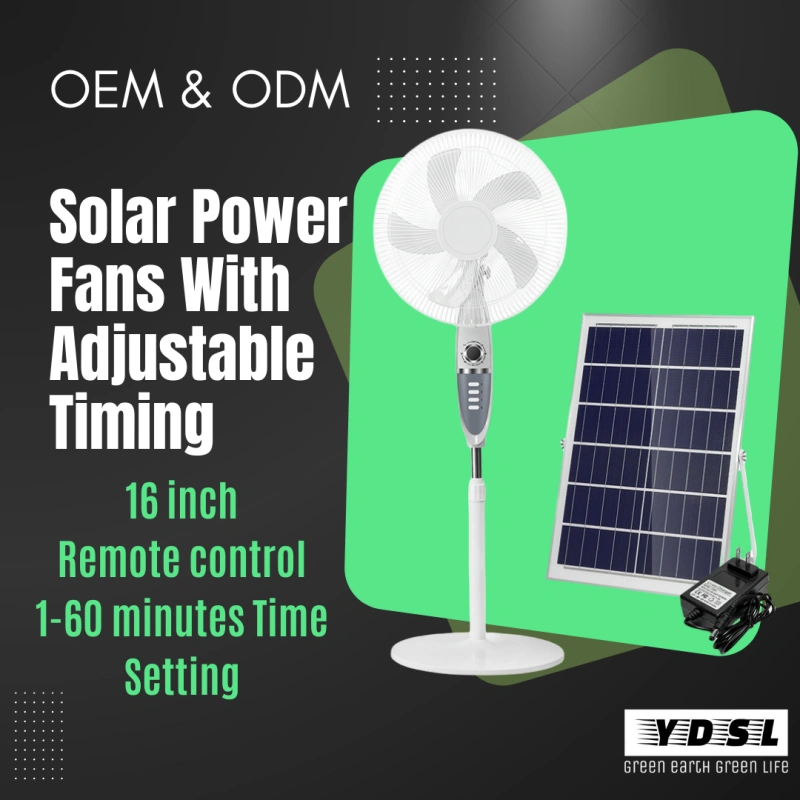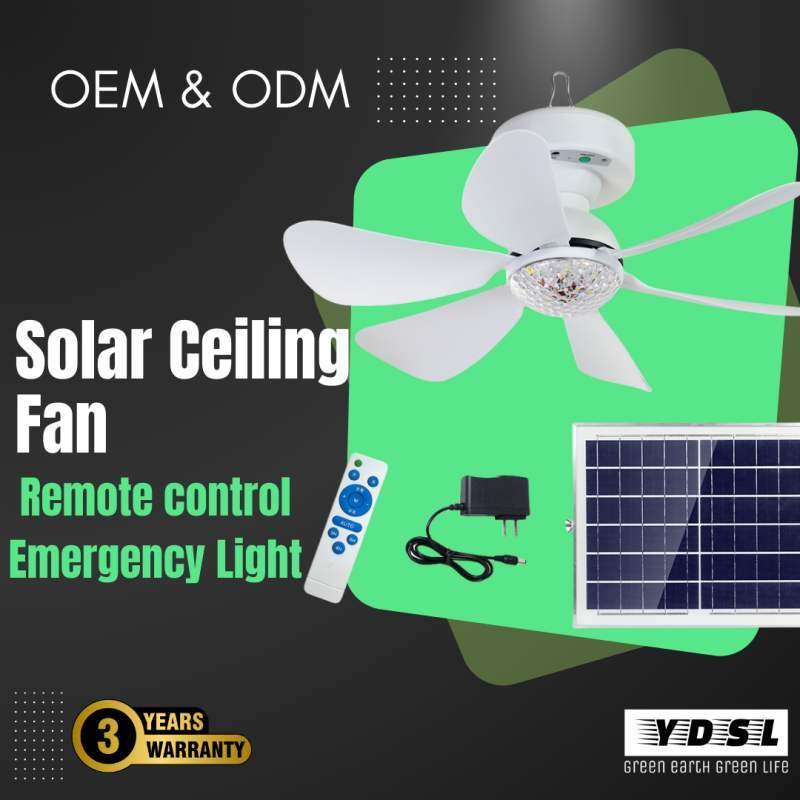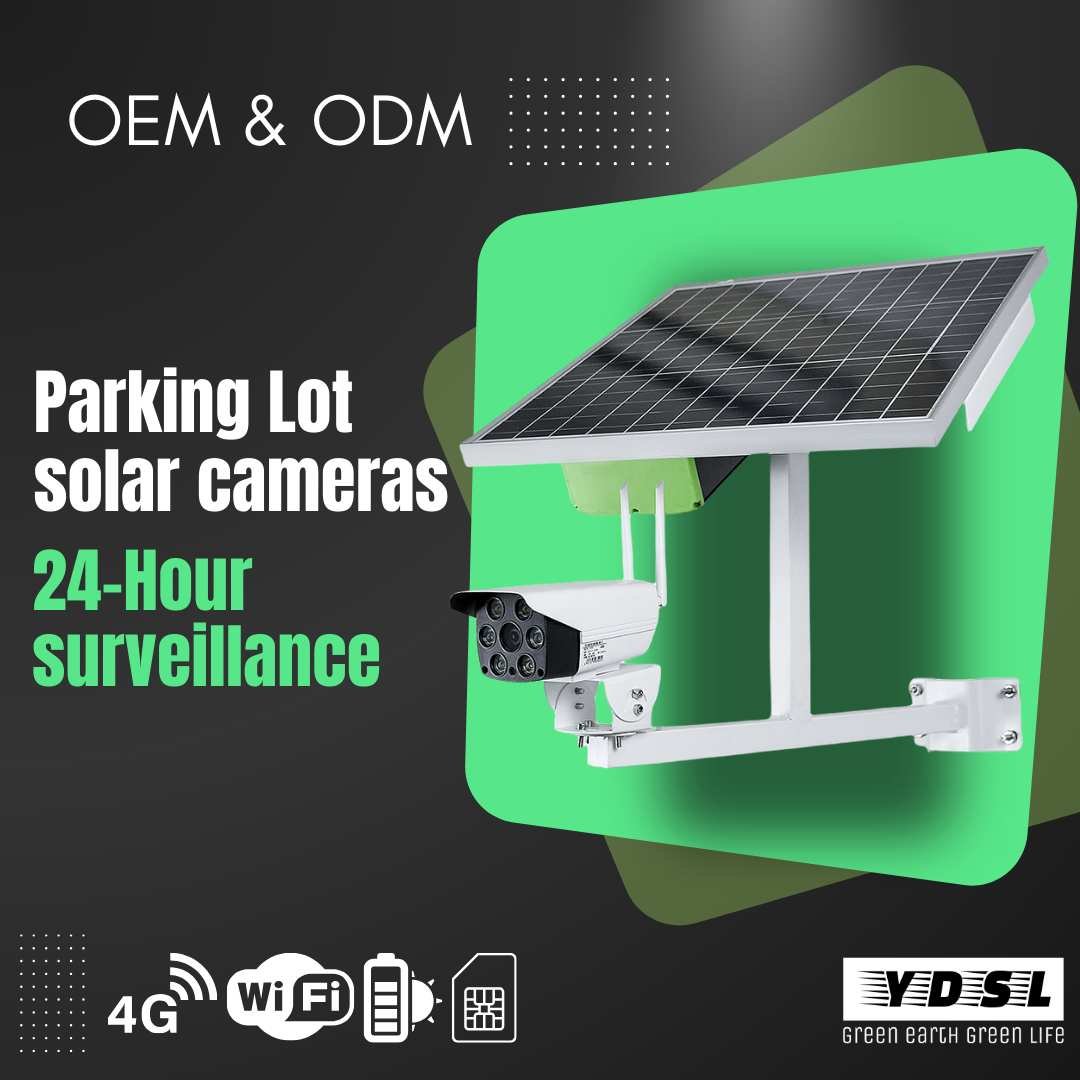Home » Solar Air Conditioning » Solar Air Conditioner Supply: Top-rated Solar AC Manufacturer
Solar Air Conditioner Supply: Off-Grid Solar AC Manufacturer
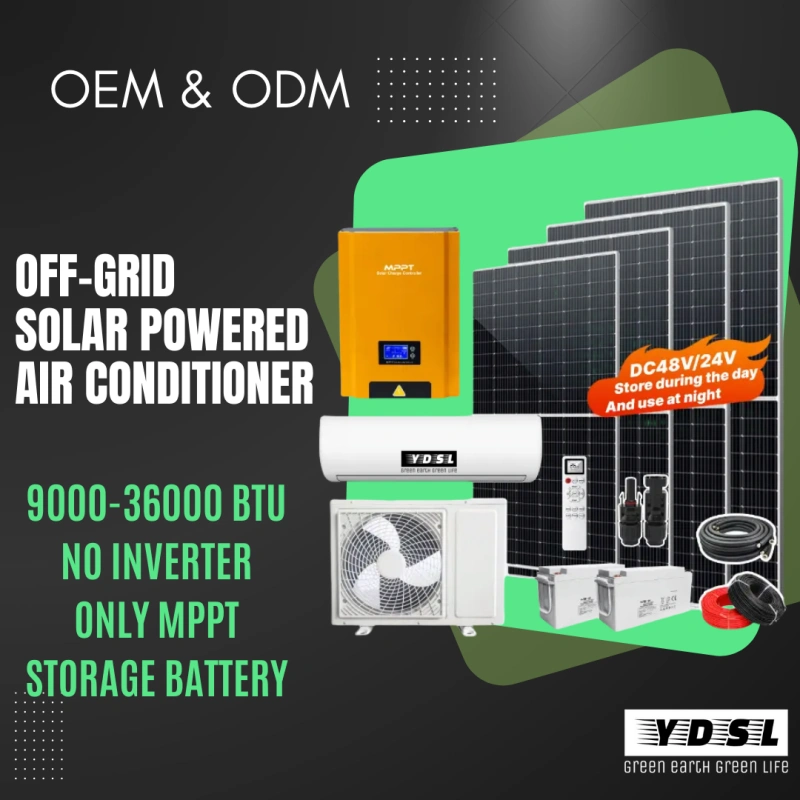
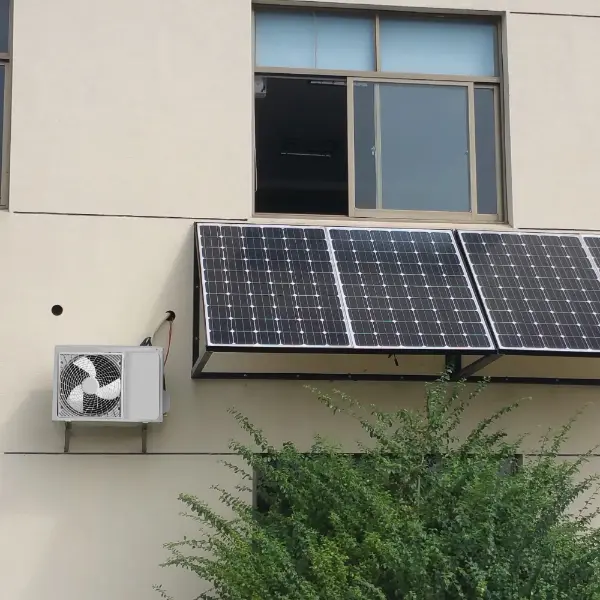
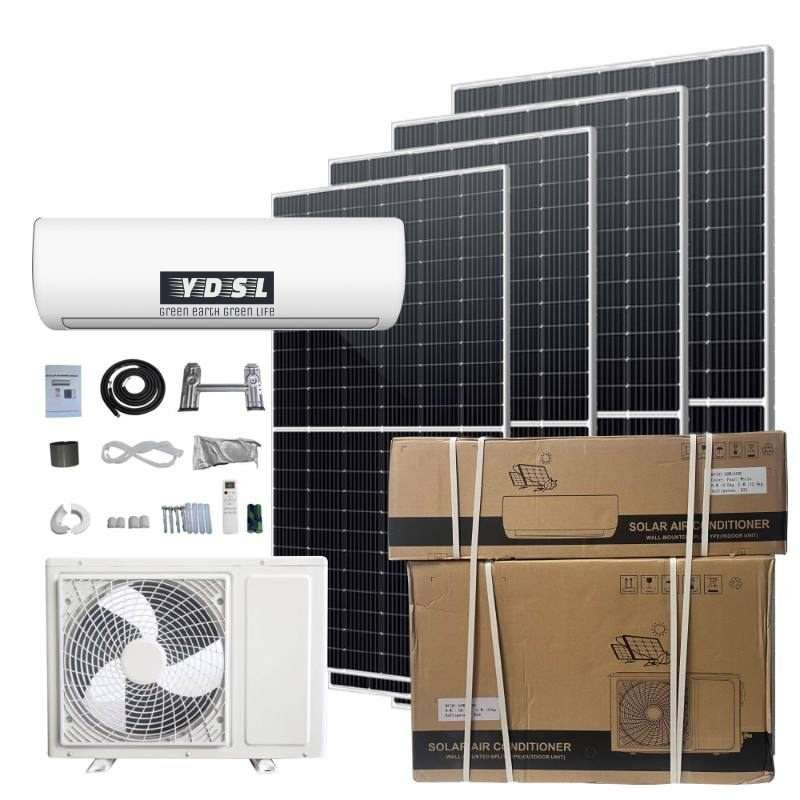

YDSL brand the manufacturer of off-grid solar air conditioner 24V/48V overviews:
- 100% of energy saved during the day. Just solar power is used.
- 9000 BTU, 12000 BTU, 18000 BTU, and the highest choice of 36000 BTU
- DC Power supply options include 48V/24V,
- MPPT solar controller, battery included, 100% off-grid system
- Applying a smartphone for smart control APP
- Cooling & heating two system
- DC inverter compressor motor
- Broad operating temperature range (-20 to 60 °C)
- If you want to choose on-grid system, please refer to hybrid solar powered AC system
- A/C unit with a three-year guarantee and solar panels with a 25-year warranty
Quick Browsing
ToggleTechnical Specifications
| Model | Unit | BY-26GW/DC24V | |
| Power Supply | V | DC 21-29V | |
| Cooling | Capacity | Blu/h | 9000 |
| Powe Input | W | 570 | |
| Current | A | 19 | |
| Compressor | \ | DC24V | |
| EER | W/W | 4.56 | |
| Blu/h/w | 15.79 | ||
| SEER | Blu/h/w | 23.6 | |
| Indoor Air Flow(H/M/L) | m3/h | 450 | |
| Indoor Noise(H/M/L) | dB(A) | ≤40 | |
| Indoor Unit | Net Size (W*D*H) | mm | 775*260*210 |
| Pack Size (W*D*H) | mm | 840*325*265 | |
| Net/Gross | Kg | 7/9 | |
| Outdoor Noise | dB(A) | ≤50 | |
| Outdoor Unit | Net Size (W*D*H) | mm | 790*260*540 |
| Pack Size (W*D*H) | mm | 910*370*610 | |
| Net/Gross | Kg | 25/28 | |
| Operation Temp | ℃ | 16 – 30 | |
| Ambient Temp (cooling&heating) | ℃ | -15 – 60 | |
| Application area | ㎡ | 12-18 | |
| Model | Unit | BY-35GW/DC48V | |
| Power Supply | V | DC 42-60V | |
| Cooling | Capacity | Blu/h | 12000 |
| Powe Input | W | 750 | |
| Current | A | 16 | |
| Compressor | \ | DC48V | |
| EER | W/W | 4.67 | |
| Blu/h/w | 16.00 | ||
| SEER | Blu/h/w | 24.3 | |
| Indoor Air Flow(H/M/L) | m3/h | 450 | |
| Indoor Noise(H/M/L) | dB(A) | ≤42 | |
| Indoor Unit | Net Size (W*D*H) | mm | 775*260*210 |
| Pack Size (W*D*H) | mm | 840*325*265 | |
| Net/Gross | Kg | 8/10 | |
| Outdoor Noise | dB(A) | ≤52 | |
| Outdoor Unit | Net Size (W*D*H) | mm | 790*260*540 |
| Pack Size (W*D*H) | mm | 910*370*610 | |
| Net/Gross | Kg | 28/31 | |
| Operation Temp | ℃ | 16 – 30 | |
| Ambient Temp (cooling&heating) | ℃ | -15 – 60 | |
| Application area | ㎡ | 16-23 | |
| Model | Unit | BY-50GW/DC48V | |
| Power Supply | V | DC 42-60V | |
| Cooling | Capacity | Blu/h | 18000 |
| Powe Input | W | 900 | |
| Current | A | 22 | |
| Compressor | \ | DC48V | |
| EER | W/W | 4.78 | |
| Blu/h/w | 20.00 | ||
| SEER | Blu/h/w | 25.2 | |
| Indoor Air Flow(H/M/L) | m3/h | 550 | |
| Indoor Noise(H/M/L) | dB(A) | ≤43 | |
| Indoor Unit | Net Size (W*D*H) | mm | 990*320*210 |
| Pack Size (W*D*H) | mm | 1070*395*285 | |
| Net/Gross | Kg | 13/15 | |
| Outdoor Noise | dB(A) | ≤54 | |
| Outdoor Unit | Net Size (W*D*H) | mm | 850*290*580 |
| Pack Size (W*D*H) | mm | 995*390*665 | |
| Net/Gross | Kg | 35/38 | |
| Operation Temp | ℃ | 16 – 30 | |
| Ambient Temp (cooling&heating) | ℃ | -15 – 60 | |
| Application area | ㎡ | 24-35 | |
Model
Unit
BY-70GW/DC48V
Power Supply
V
DC 42-60V
Cooling
Capacity
Blu/h
24000
Powe Input
W
1300
Current
A
30
Compressor
\
DC48V
EER
W/W
4.8
Blu/h/w
18.46
SEER
Blu/h/w
25.6
Indoor Air Flow(H/M/L)
m3/h
650
Indoor Noise(H/M/L)
dB(A)
≤50
Indoor Unit
Net Size
(W*D*H)
mm
990*320*210
Pack Size
(W*D*H)
mm
1070*395*285
Net/Gross
Kg
15/17
Outdoor Noise
dB(A)
≤58
Outdoor Unit
Net Size
(W*D*H)
mm
850*310*710
Pack Size
(W*D*H)
mm
1025*395*790
Net/Gross
Kg
42/45
Operation Temp
℃
16 – 30
Ambient Temp
(cooling&heating)
℃
-15 – 60
Application area
㎡
32-47
| Model | Unit | BY-100GW/DC48V | |
| Power Supply | V | DC 42-60V | |
| Cooling | Capacity | Blu/h | 36000 |
| Powe Input | W | 1800 | |
| Current | A | 38 | |
| Compressor | \ | DC48V(Double) | |
| EER | W/W | 4.65 | |
| Blu/h/w | 17.55 | ||
| SEER | Blu/h/w | 24.1 | |
| Indoor Air Flow(H/M/L) | m3/h | 1050 | |
| Indoor Noise(H/M/L) | dB(A) | ≤52 | |
| Indoor Unit | Net Size (W*D*H) | mm | 1080*220*327 |
| Pack Size (W*D*H) | mm | 1155*310*405 | |
| Net/Gross | Kg | 13.7/17.2 | |
| Outdoor Noise | dB(A) | ≤64 | |
| Outdoor Unit | Net Size (W*D*H) | mm | 946*410*810 |
| Pack Size (W*D*H) | mm | 1090*500*860 | |
| Net/Gross | Kg | 65/73 | |
| Operation Temp | ℃ | 16 – 30 | |
| Ambient Temp (cooling&heating) | ℃ | -15 – 60 | |
| Application area | ㎡ | 47-63 | |
What is Air Conditioner Off Grid?
These are air conditioners that don’t connect to the main power grid and get their power from the sun. This type of AC is called “off-grid solar-powered AC.” This kind of method is especially helpful in remote areas, places where the power isn’t always on, or for people who want to lower their daily cost and use fewer fossil fuels.
How Does an Off-Grid Solar Air Conditioner Work?

An off-grid solar air conditioner is a cooling device that doesn’t need to be connected to the main power grid. It runs on solar energy alone. The way it works can be broken down into the steps below:
1. Solar Power Generation
Solar panels turn light from the sun into direct current (DC) energy. Usually, these panels are put up on roofs or in places that get a lot of sunlight so that they can collect the most energy.
2. Energy Storage
Off-the-grid air conditioners need a battery storage system because solar energy is intermittent (it’s only available during the day). Batteries store the extra energy that the solar panels make so that it can be used at night or when it’s cloudy.
3. Power Conversion
Solar panels make direct current (DC), which is different from electrical current (AC), which is what air units use. To make AC electricity for the air conditioner, an off-grid system needs an inverter to change the DC energy from the batteries.
Air Conditioner Operation
The solar air conditioner is run by the changed AC power. The batteries store energy that the system uses to make sure there is a steady flow of electricity, even when solar energy isn’t being made.
5. Energy Management
The best off-grid solar air conditioners usually come with a method that helps you use power more efficiently. This method makes sure that the air conditioner works well by using the least amount of energy during peak sunlight hours and using more battery power when it’s needed.
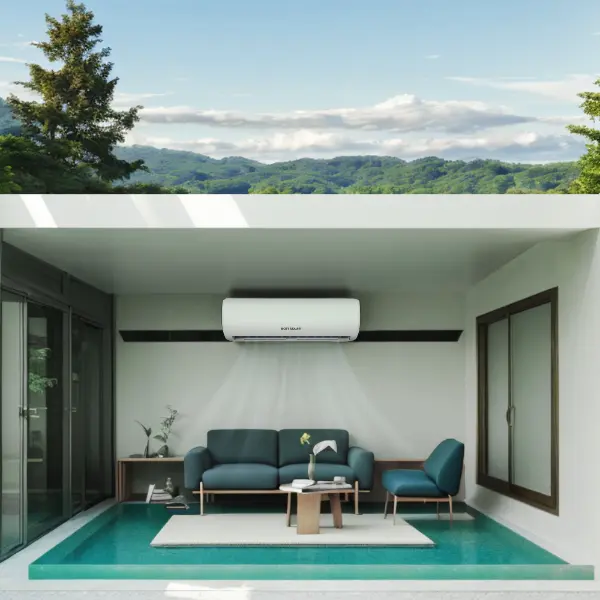

Two Types Of solar panels for Options
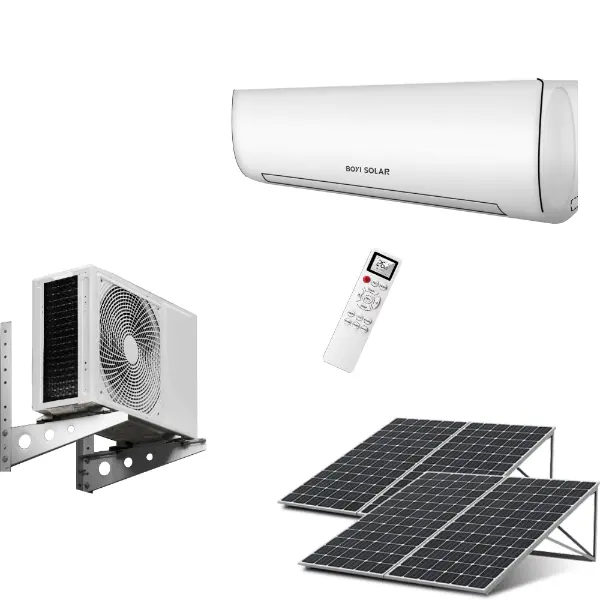
It is very important to choose the right type of solar panels for AC if you want your off-grid solar air conditioner system to work well and be stable. It will help you decide by showing you how efficient polycrystalline and monocrystalline solar panels are, where they can be used, and how many solar panels you need to power an air conditioner. You can make a smart choice and get the most out of your solar air conditioner setting if you know these things.
1. Polycrystalline Solar Panels
Polycrystalline solar panels are made from silicon crystals that are melted together. Here are their main features:
- Efficiency: Polycrystalline panels have an efficiency rate of about 15–17%. They are generally less efficient than monocrystalline panels, but they are still effective in areas with ample sunlight.
- Cost: These panels are typically less expensive due to their simpler manufacturing process.
- Lifespan: They can last 25 years or more with proper maintenance.
- Appearance: Polycrystalline panels have a blue hue and a speckled look due to the multiple silicon crystals used.
2. Monocrystalline Solar Panels
Monocrystalline solar panels are made from a single crystal of silicon, providing a uniform look and higher efficiency. Key characteristics include:
- Efficiency: Monocrystalline panels boast an efficiency rate of 18-22%, making them the most efficient type of solar panel available.
- Cost: These panels are more expensive due to the complex manufacturing process.
- Lifespan: Like polycrystalline panels, they often exceed 25 years of lifespan.
- Appearance: They have a sleek black appearance due to the high-purity silicon used.
Suitable Regions
- Poly Panels: They perform well in moderate to high sunlight areas. They are suitable for regions with consistent sunlight throughout the year but can be less efficient in very high temperatures.
- Mono Panels: These panels are pefect for both high and low sunlight areas. They perform better in lower light conditions and high temperatures, making them versatile for various climates.
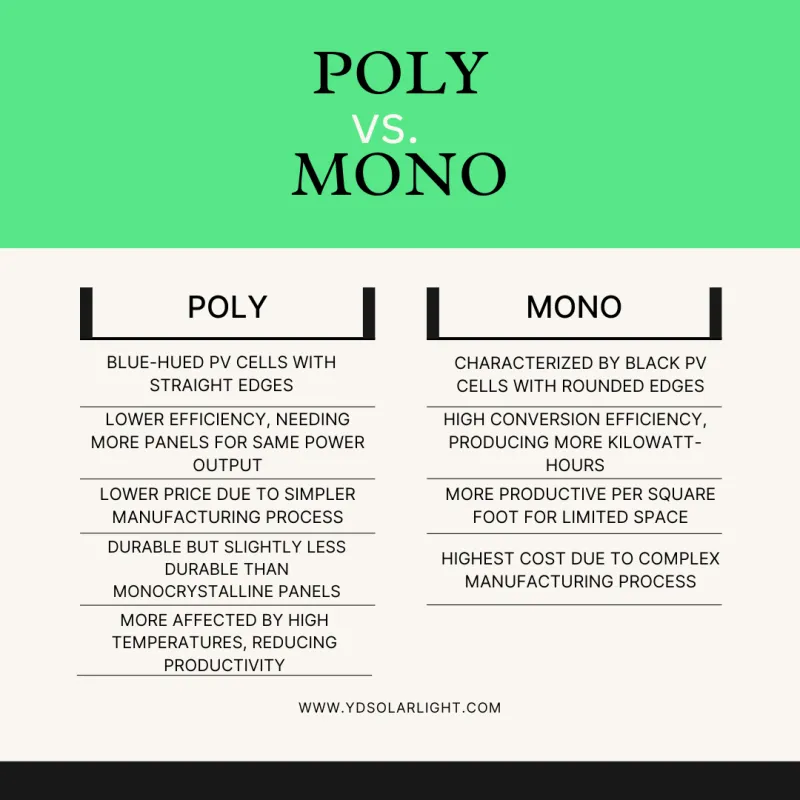
Two Types of Batteries for Options

1. Lithium Iron Phosphate (LiFePO4) Batteries
Lithium Iron Phosphate batteries are renowned for their numerous benefits. Here’s why they are an excellent choice for solar air conditioners:
High Energy Density and Compact Size
LiFePO4 batteries have a high energy density, which means they can hold more power in a smaller space. This is especially helpful for solar air conditioners that don’t have a lot of room.
Fast Charging
These batteries can be charged quickly, which means that solar panels can quickly charge them during the day. This makes sure that the solar power system on your air conditioner always has power.
Long Lifespan
LiFePO4 batteries have a deep cycle charging capacity of 1500-2000 cycles. Under normal usage conditions, a single LiFePO4 battery can last between 8 to 10 years, making them a cost-effective solution over time.
Wide Operating Temperature Range
These batteries can operate in extreme temperatures ranging from -40°C to 70°C. However, in extremely cold environments, to keep things running at their best, it is suggested to use extra heating devices.
2. Lead-Acid Gel Batteries
Lead-Acid Gel batteries are an upgraded version of traditional lead-acid batteries. They offer several improvements and are another viable option for solar air conditioners:
Maintenance-Free
One of the best things about Lead-Acid Gel batteries is that they don’t need any upkeep. They solve the problems that come up with regular lead-acid batteries that need to be fixed often.
Improved Performance
Lead-Acid Gel batteries store more energy, discharge more quickly, are safer, and last longer because they use gel electrolytes instead of sulfuric acid electrolytes.
Wide Temperature Range
The temperatures at which these batteries can work are between -40°C and 65°C. Because they work well in low temperatures, they can be used in cold northern areas.
High Shock Resistance
Lead-Acid Gel batteries are better at handling shocks, so they can work safely in a wide range of harsh circumstances.
The above two types of batteries should be judged based on your budget and the actual situation of the local weather environment.

Configuration reference table for solar air conditioners
| Model | Solar Panel | Battery | MPPT |
| 9000 BTU | 400W*3 | 12V 100Ah*4 | 48V 30A |
| 12000 BTU | 400W*3 | 12V 120Ah*4 | 48V 30A |
| 18000 BTU | 400W*3 | 12V 140Ah*4 | 48V 40A |
| 24000 BTU | 400W*3 | 12V 180Ah*4 | 48V 50A |
Benefits of MPPT for solar air conditioning Units
Improving the Conversion of Energy
MPPT controllers make sure that solar panels work at their best by increasing the energy they convert. This ongoing change makes sure that the panels get the most energy possible, even when the sun isn’t shining directly on them.
Extending longer battery life
MPPT charge controllers make the charging process safe and efficient, which extends the life of batteries. They also get the most power from solar panels, which keeps batteries from getting stressed out from frequent discharge cycles.
Making the system more reliable
The controllers keep an eye on the solar panels and change their working point to account for things like shade, changes in temperature, and obstacles. This ability to adapt makes sure that performance stays the same all year, even when the world changes.
Power Management That Works
MPPT controllers manage power distribution between solar panels, batteries, and the solar power air conditioner. They store extra energy in batteries during the hours of maximum sunshine and use the batteries to get power when there isn’t enough sunlight.
Reducing Overall Costs
Even though they cost more at first, MPPT controllers save a lot of money in the long run. Lowering your energy bills and maintenance costs makes solar-powered AC supply with MPPT a smart investment.
Smart APP Control

Voice Control
If you say something like “Hey Google, set the air conditioner to cooling mode” or “Jim, set the living room air conditioner to 72 degrees,” you can change the settings without having to do anything.
Easy to Use Control from Anywhere
Changing the temperature: With an internet connection and the TUYA app, users can change the temperature of their solar air conditioner from anywhere. You can keep your house at the right temperature even when you’re not there, like when you’re at work, on vacation, or just in a different room.
Change of Mode: This app lets users switch between different cooling modes. This makes sure that the air conditioner always works, no matter what time of year it is.

Applications of Off-Grid Solar-Powered Air Conditioner
Residential Applications
Scenario: A family living in a suburban area installs a air conditioner solar power system to reduce their energy bills.
1. Energy Savings: When it’s sunny, the system uses solar energy first, which cuts down on power costs by a lot.
2. Benefits on the Earth: If the family uses fewer natural energy sources, it may have less of an effect on the environment.
3. Dependability: By moving to the regular power grid at night or on cloudy days, the off-grid system makes sure that the solar air conditioner for home works well.

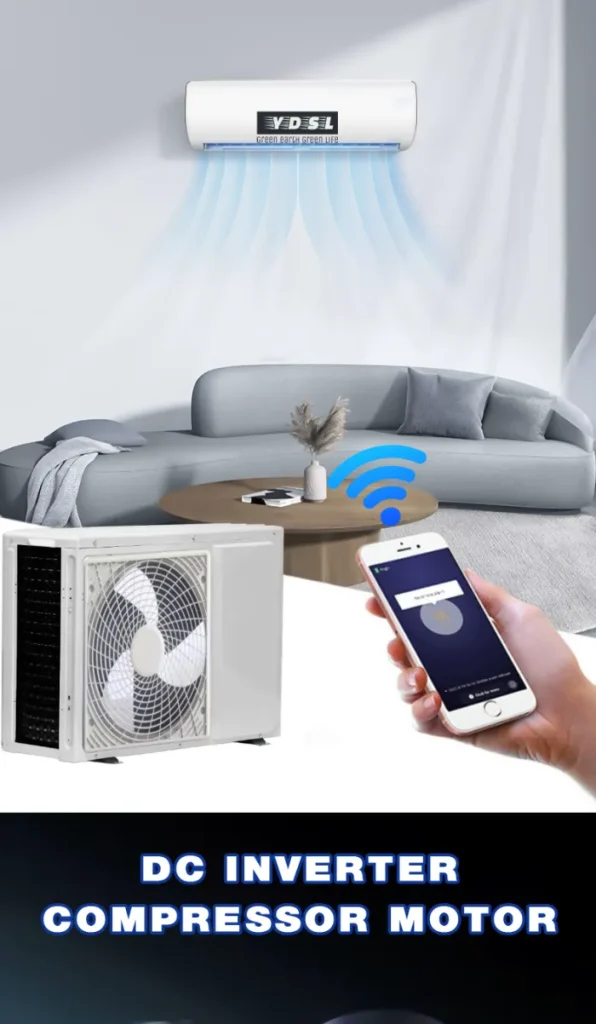
Office Buildings
1. Cost savings in processes: Using solar power during peak daylight hours has led to a big drop on electricity bills.
2. A sustainable future: Using alternative energy sources makes the company look greener.
3. Health for Employees: Makes sure that the air conditioning works regularly, which makes the workplace better.
Shopping Malls
Scenario: A shopping mall installs a hybrid solar air conditioning system to manage the cooling demands of large indoor spaces.
1. Cost management: Lowers the mall’s total electricity use, which means lower costs to run the business.
2. Customer Experience: Keeps the store comfortable, which leads to longer stays and more sales.
3. The image of the brand: Shows the mall as a business that cares about the natural world, which brings in customers who care about environmental issues.

Installation and Maintenance
Positioning and mounting solar panels:
Solar panels should be placed at an angle that lets them get the most sun. Make sure the frame for mounting is stable and can handle the weather where you are. When wiring, connect the solar cells in either series or parallel, depending on how they were designed. To make sure of safety and speed, use the right wiring and connectors.
Setting up the battery and MPPT controller:
Put the lithium batteries somewhere cool and dry, out of the way of direct sunlight and high temperatures.
Link the solar panels to the MPPT controller. The controller will then link to the batteries. The MPPT processor will control the voltage and current to make sure the battery charges properly and stays healthy.


Air Conditioner Units Installation:
Indoor Unit:
1. Put the indoor unit somewhere that lets air flow well and is easy to get to for upkeep.
2. Use the clamps that come with the indoor unit to attach it to the wall. Make sure it is level so that the condenser drain doesn’t leak water.
3. Follow the manufacturer’s directions to connect the indoor unit to the power source and the outdoor unit to the indoor unit.
Outdoor Unit:
1. Put the outdoor unit somewhere with good airflow and shade, if possible, to keep it from getting too hot and to get the most out of it.
2. To keep the outdoor unit in place, use a stable surface or a hanging bracket. Make sure it’s level and that there’s enough space for air to flow.
3. Join the electrical wire, condensate drain line, and refrigerant lines between the indoor and outdoor units. Follow YDSL’s instructions to make sure that all of your links are safe and don’t leak.
System Testing
Initial Testing:
Once the installation is complete, the system needs to be thoroughly tested. This involves checking the solar panel output, MPPT controller functionality, battery charge and discharge cycles, and the overall performance of the air conditioning system.
Performance Verification:
Ensure that the solar air conditioner kit is operating correctly and efficiently. Test the cooling performance of the air conditioner and verify that the solar panels and batteries are working as expected.
Final Checks:
Perform a final inspection to confirm that all components are securely installed and that the system complies with local regulations and standards.
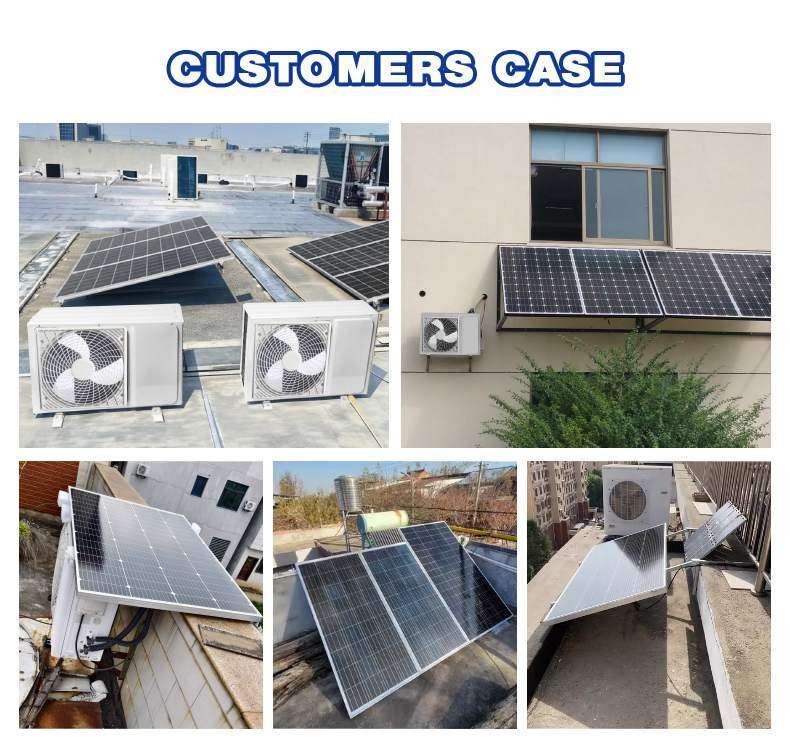
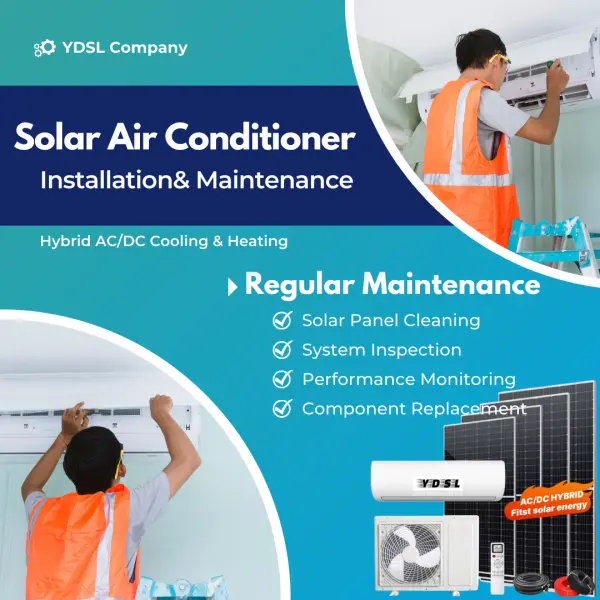
Regualr maintenance
Solar Air Conditioner System Maintenance Tips:
1. Solar panels should be cleaned regularly so that they can absorb as much sunlight as possible.
2. When workers do inspections, they find possible problems before they get worse.
3. YDSL solar AC supply systems come with tools that let you check on how well they’re working. You can check to see if the system is working right and get alerts if something is not right.
4. Keeping an eye on inverters or batteries on a regular basis ensures their long-term dependability and efficiency.
FAQS
1. What are the disadvantages of solar air conditioner?
The main problems are that it costs a lot to buy and install the equipment, the best results rely on the weather, and solar panels may break down over time. The price will go up if battery packs and transformers are added. Solar panels aren’t as popular on the market as regular AC units.
2. What are the benefits of off-grid solar powered air conditioning??
When we use solar power for our off grid air conditioner, we don’t have to think about anything. On days when it’s cloudy or wet, we can still use the energy stored in lithium batteries. In places that don’t have electricity, this is particularly helpful.
3. How do I know the customized solar air conditioner price?
Keep in mind how much cooling you need.
1. Figure out how much cooling space you have in feet or square meters. More powerful air conditioners are needed in bigger rooms, which cost more.
2. Figure out the AC’s daily hours of use. If demand goes up, you may need more solar panels and batteries, which will cost more.
3. The price is directly related to the AC cooling ability (1, 1.5, 2 tons). More space is in more expensive units. To save energy, pick units with better EER or SEER ratings. Versions that use less energy cost more at first but pay for themselves in the long run.
4. Figure out how many solar panels you need.
How many solar panels you need will depend on how much sunlight you get and how much AC power you use. For a 1.5-ton AC, you might need 8–10 250W solar cells. Polycrystalline screens are cheaper than monocrystalline ones, but monocrystalline ones are more efficient.
5. Keep batteries for off-grid systems in a safe place. Living off the grid means you need batteries for the nights and cloudy days. To find out what size battery you need (150Ah or 200Ah), you need to know how much power your AC uses and how many hours it is on.
4. How many solar panels to power air conditioner?
- 9000 BTU 400 W Solar Panel * 4-6 pcs
- 12000 BTU 400 W Solar Panel * 4-7 pcs
- 18000 BTU 400 W Solar Panel * 5-8 pcs
- 24000BTU 400 W Solar Panel * 6-8 pcs
- 36000 BTU 600 W Solar Panel * 6-8 pcs
5. What's the warranty period for solar AC units?
The YDSL solar panel air conditioner comes with a three-year warranty. For more information, please contact us.
6. What are the contents of the warranty?
We will give clients free accessories and online technical help as long as the product is still under the quality assurance time. Users can get free replacement parts since batteries are dangerous things that can’t be shipped separately.
7. Who will pay for the shipping cost of accessories during the warranty period?
If a customer keeps buying our goods from our factory, we’ll send them free replacement parts as long as they are still under warranty. Customers who only need accessories and don’t need to buy anything else can get those accessories for free, but they have to pay for shipping (except for batteries, which can’t be sent).
8. What is the difference between DC48V/24V solar AC and regular AC?
There is only one difference between them: where and how the power comes from. What kind of weather you have where you live and how hot it is can determine how much DC sun power your solar air conditioner needs. Running the AC doesn’t cost anything because the process doesn’t need AC power.
Related Products

Green lighting for a green life.
Professional and intelligent manufacturer
- Email: info@ydsolarlight.com
- Whatsapp: +86 18912106317
- Wechat: owen17173
© 2025 All Rights Reserved.

